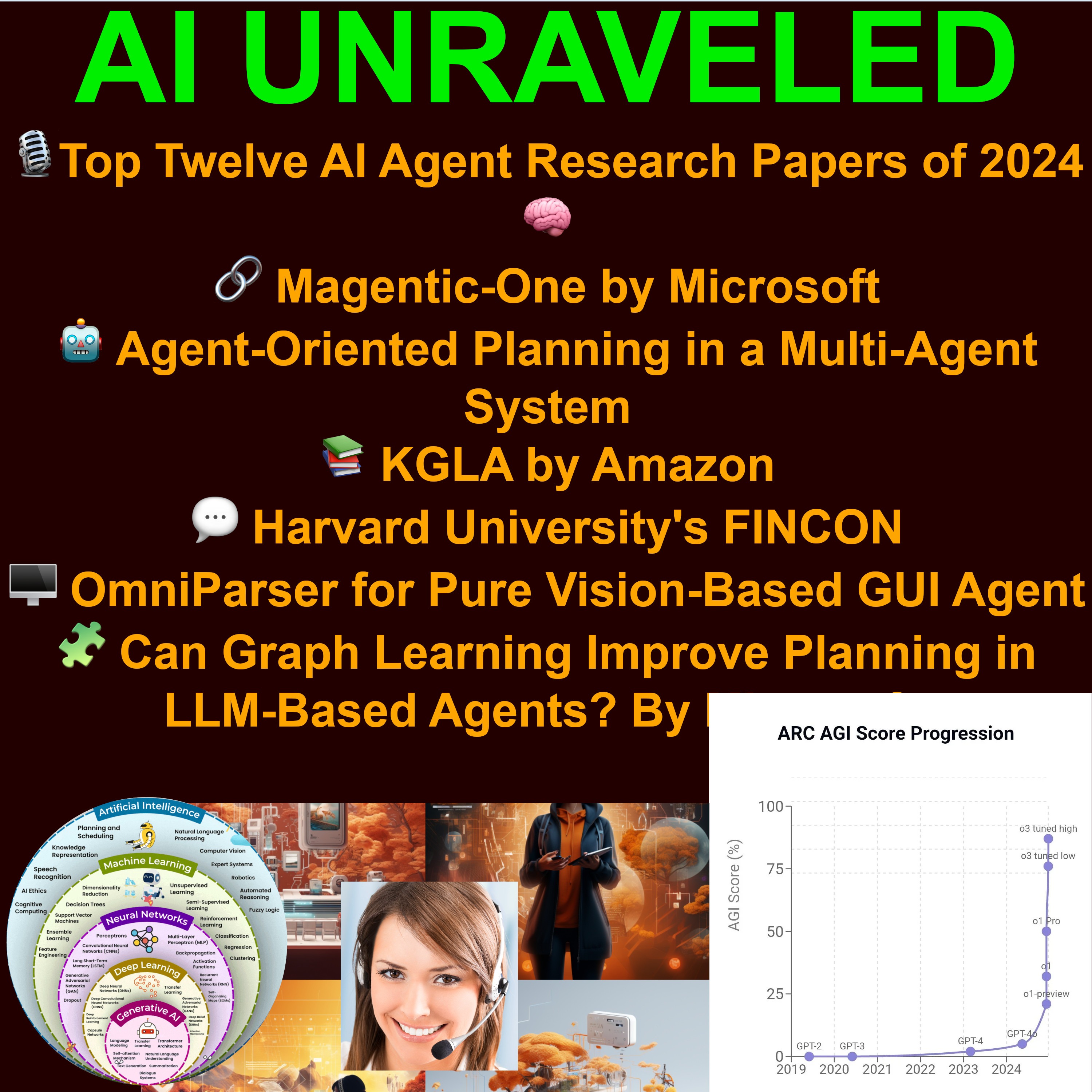
🧩Top Twelve AI Agent Research Papers of 2024🐞

AI Unraveled: Latest AI News & Trends, GPT, ChatGPT, Gemini, Generative AI, LLMs, Prompting
Deep Dive
What is the significance of Microsoft's Magentic-One in AI agent research?
Magentic-One is a multi-agent system designed to handle web-based and file-based tasks across various domains. It uses specialized AI agents that collaborate to achieve larger goals, such as research, data analysis, and report generation, showcasing the power of collective intelligence in AI systems.
How does Amazon's KGLA framework enhance AI agents' capabilities?
Amazon's KGLA framework integrates knowledge graphs, allowing AI agents to access vast networks of facts and relationships. This enables them to reason, make connections, and solve problems more effectively, such as providing personalized customer support or identifying financial risks.
What is the focus of Harvard University's FinCon research?
FinCon explores how AI agents can learn through simulated financial conversations, refining their understanding of financial markets and strategies. This conversational verbal reinforcement allows AI agents to develop financial intuition and adapt to complex scenarios.
What makes OmniParser a groundbreaking development in AI agent research?
OmniParser enables AI agents to navigate graphical user interfaces (GUIs) using only visual cues, allowing them to interact with software similarly to humans. This adaptability eliminates the need for explicit programming for each new interface, making AI agents more flexible and efficient.
How does graph learning improve planning in AI agents, as shown in Microsoft's research?
Graph learning allows AI agents to interpret visual representations of relationships, helping them grasp complex connections and make strategic decisions. This approach enables agents to analyze the bigger picture and develop nuanced plans of action in dynamic environments.
What is the significance of Stanford and Google DeepMind's research on simulating 1,000 people's vocal patterns?
This research demonstrates AI's ability to generate realistic human voices, enabling applications like natural-sounding virtual assistants, lifelike simulations for training, and personalized learning experiences. It also raises ethical questions about the use of such technology.
How does ByteDance's research on LLM-based agents impact software development?
ByteDance's research compares large language models (LLMs) for automated bug fixing, aiming to streamline development, reduce human error, and improve software quality. AI agents can identify and fix bugs automatically, allowing developers to focus on higher-level tasks.
Why does sparse communication topology improve multi-agent debate, according to Google DeepMind?
Sparse communication limits direct interaction between agents, reducing noise and confusion. This structured approach allows agents to present clear, evidence-based arguments, leading to more focused and insightful debates, which is crucial for collaborative problem-solving.
What are the key takeaways from OpenAI's paper on governing agentic AI systems?
OpenAI emphasizes the importance of transparency, accountability, and robust oversight mechanisms to ensure AI agents operate safely and ethically. The paper highlights the need for clear guidelines and multidisciplinary collaboration to align AI systems with human values.
How does Anthropic's Sonnet 3.5 case study demonstrate advancements in AI agent usability?
Sonnet 3.5 showcases an AI system that interacts with computer interfaces intuitively, similar to how humans would. This focus on user-friendliness and accessibility makes AI agents more approachable for non-technical users, bridging the gap between human intuition and machine capabilities.
What are the potential economic impacts of AI agents on the workforce?
While AI agents may automate some jobs, they also create new opportunities in human-AI collaboration, critical thinking, and creativity. Historical technological advancements, like the internet, show that disruption often leads to new industries and professions, requiring adaptation and upskilling.
Why is explainable AI (XAI) crucial for the future of AI agents?
Explainable AI ensures that AI agents can provide transparent reasoning for their decisions, fostering trust and accountability. This is especially important for critical tasks like financial decision-making, medical diagnosis, and autonomous vehicle control, where understanding the decision process is essential.
- AI agents are like specialized digital assistants.
- They work together and learn from each other.
- Collaborative aspect drives advancements.
Shownotes Transcript
**🔗 **Magentic-One by Microsoft:)
Update to the Autogen framework, discussing a generalist multi-agent system for solving open-ended web and file-based tasks across a variety of domains.
**🤖 **Agent-Oriented Planning in a Multi-Agent System:)
Introduces a framework utilizing Meta-agent architecture for clever planning in multi-agent systems.
📚 KGLA by Amazon:
Amazon's Knowledge Graph-Enhanced Agent framework for better knowledge retrieval across various domains.
💬 Harvard University's FINCON:
Researchers propose an LLM-based multi-agent framework with conversational verbal reinforcement for diverse financial tasks.
**🖥️ **OmniParser for Pure Vision-Based GUI Agent:)
A multi-agent approach for UI navigation for GUI-based AI agents.
🧩 Can Graph Learning Improve Planning in LLM-Based Agents? By Microsoft:
Experiment showing how graph learning improves planning in AI agents using GPT-4 as their core LLM.
**👥 **Generative Agent Simulations of 1,000 People by Stanford and Google DeepMind:)
Experiment demonstrating AI agents cloning 1,000 people using just 2 hours of audio.
🐞 An Empirical Study on LLM-Based Agents for Automated Bug Fixing:
ByteDance explores which LLMs are best suited for automated bug fixing.
**💬 **Google DeepMind's Sparse Communication for Multi-Agent Debate:)
Experiment improving agent communication with limited information sharing.
**📊 **LLM-Based Multi-Agents: A Survey:)
Comprehensive review of the progress and challenges in LLM-based multi-agent systems.
⚙️ Practices for Governing Agentic AI Systems by OpenAI:
OpenAI outlines seven tips for creating safe and accountable AI agents for businesses.
**🖥️ **The Dawn of GUI Agent: A Case Study for Sonnet 3.5:)
Paper examining Anthropic's usability for GUI-based AI across various domains.
AI and Machine Learning For Dummies: Your Comprehensive ML & AI Learning Hub [Learn and Master AI and Machine Learning from your iPhone) ]
Discover the ultimate resource for mastering Machine Learning and Artificial Intelligence with the "AI and Machine Learning For Dummies" app.
iOs: https://apps.apple.com/ca/app/machine-learning-for-dummies/id1611593573)
PRO Version (No ADS, See All Answers, Practice Tons of AI Simulations, Plenty of AI Concept Maps, Pass AI Certifications): https://apps.apple.com/ca/app/machine-learning-for-dummies-p/id1610947211)